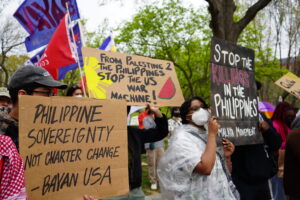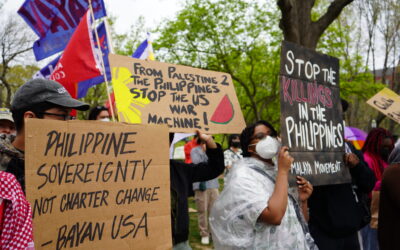The Marcos Jr administration knows that we all want good news because, well, who doesn’t. Unfortunately, the government is taking advantage of this to manage citizens’ perception of the economy to preempt public outcry and demands for pro-people economic policies.
Where the Philippine economy is today is a case in point. In its yearend narratives, the administration declared that the economy “performed well in 2023” and will “maintain [it’s] economic progress for [2024] and beyond.” The joy was fitting for the holiday season and for the spontaneous optimism at the start of the New Year when, well, we all want to be hopeful.
The only problem is that it isn’t true. The Philippine economy didn’t do that well in 2023 and actually started 2024 on weak footing.
Jobless growth
The government’s main basis for claiming success is the very narrow and grossly overrated indicator of economic growth. It insists that Philippine gross domestic product (GDP) growth last year made it “among the best-performing economies in Asia” and will be even faster this year.
The country’s 5.9% GDP growth in the third quarter of 2023 was certainly the fastest reported in the region – more than in Vietnam (5.3%), Indonesia (4.9%), Malaysia (3.3%), Thailand (1.5%) and Singapore (1.1%) for the same period and certainly better than Brunei’s 3.1% contraction in the second quarter. But the endorphin rush that figures like this might trigger is unjustified.
While Philippine growth hit 5.5% for the first nine months of the year, the latest labor force data for November 2023 reports that total employment actually fell by 70,000 from the same period the year before to 49.6 million. This is statistically insignificant but the conclusion is unassailable – the hyped “best-performing” growth is actually the much-feared jobless growth.
How to reconcile this with government’s good news that the unemployment rate is at its lowest level since 2005? Unfortunately, there are many more jobless Filipinos than the official unemployment statistics report. Hundreds of thousands of discouraged and other jobless Filipinos – or perhaps even millions – aren’t counted as unemployed and instead casually disregarded as “not in the labor force”.
The real number of outright jobless Filipinos could be over four million with an unemployment rate of some 8% or even more. This is aside from how some 35-40 million Filipinos, or 70-80% of total employment, are in merely informal and low-paying work.
These estimates of true joblessness are more consistent with other important indicators of underdevelopment than the claims that the “PH labor market continues to improve, records historic low unemployment rate.”
Jobs? The Bangko Sentral ng Pilipinas (BSP) for instance reported the number of Filipino households without savings increasing from 67.1% in the first quarter of 2023 to 70.9% in the fourth quarter. IBON estimates this as a 1.2 million increase in the number of households without savings to 19.2 million by the end of 2023. Private outfit Social Weather Stations (SWS) meanwhile reported some 20.6 million or 75% of families rating themselves as poor (48%) or borderline poor (27%) in September 2023.
These contrary evidence from the BSP and SWS – and the daily lived experience of millions of families in economic distress – bely claims of either an improving labor market or a well-performing economy. Even accustomed indicators of the quality of work like underemployment, hours worked and class of worker are also failing to capture deteriorating jobs.
The extreme disconnect between economic growth and the conditions of ordinary people should also prompt serious reconsideration of the value of optimism based on being hailed as “one of the fastest growing economies… in Asia in 2023 and 2024”.
Economy for whom
Which is not to say that things aren’t going well for the country’s elites. Profits and oligarch wealth kept growing last year even astride increasing numbers of poor Filipino families.
For instance, the 285 listed firms in the Philippine Stock Exchange (PSE) saw their net income grow 21.3% in the first nine months of 2023 from the same period the year before, up Php156.2 billion to Php888.7 billion. This is while real wages fell over the same time because meager wage hikes weren’t even enough to keep up with high inflation.
The 6% inflation in 2023 was the highest in 15 years and eroded wages and other household earnings. Inflation was actually even more burdensome and higher for the poorest third of Filipino families (30%) for whom inflation last year was 6.7% including a hunger-inducing 8.3% for food.
The wealth of the Philippines’ 50 richest also kept growing and went up 13.6% in 2023, increasing by Php537.2 billion to Php4.48 trillion (US$80.6 billion) from the year before. There’s inequality even within the country’s super-rich – most of this wealth and the increase are extremely concentrated in the 10 richest whose collective wealth went up 21.9%, or by Php532.7 billion to Php2.97 trillion.
These are the corporations whose corporate income taxes fell with the Corporate Recovery and Tax Incentives for Enterprises (CREATE) Act. They are also the oligarchs whose personal income taxes became lower with the Tax Reform for Acceleration and Inclusion (TRAIN) Law, and whose wealth and political influence keep bloating unhindered by even a small billionaire wealth tax.
Although a minority in the Philippine economy, it’s for them that the hyped GDP figures seem most relevant. It is likewise with the other preferred but also narrow indicators of so-called economic performance.
There are the “investor-grade” ratings from credit rating agencies which are bizarrely portrayed as praise when all they really signify is the capacity of the government to keep repaying debt from taxing poor and middle-class Filipinos more despite tax cuts on the rich and large corporations. This is “fiscal space” at the expense of those with the least to give.
But there is just so much revenue blood to squeeze from an impoverished stone. The Marcos Jr administration has already borrowed Php3.2 trillion in just its first 17 months, which is triple the rate of the previous administration at the same start of its term. The ratings agencies are basically thanking the government for using most of its borrowings for debt service – Php2.3 trillion or 72% of borrowings went back to creditors as interest and amortization. Thus, national government debt still keeps growing and is at Php14.5 trillion already as of November 2023.
There is so-called fiscal consolidation which is portrayed as an end in itself. The national government deficit moderated to 5.7% of GDP as of the first nine months of 2023, partly from some revenue gains but mainly from containing spending, including on emergency assistance for distressed households. Yet the case can be made for a fiscal stimulus to boost consumption, aggregate demand and supply, and growth – which would also spur revenue generation.
There’s also the decades-high infrastructure spending. Growing disbursements for this from 2016 to 2019, measured as a share of GDP, didn’t stop economic growth from slowing over that period. Neither did these create foundations for boosting manufacturing or agriculture which are both in decline.
And, of course, there’s how foreign capital is deified and desperately sought. Net foreign direct investment (FDI) of US$6.5 billion in the first ten months of 2023 is down 18% from the same period the year before, and barely half the recent peak of US$12 billion in 2021. In any case, FDI contributes to domestic development only when strictly regulated and best in the context of national industrialization policy – as done historically and currently by the world’s biggest industrial powers.
Deindustrialization and decline
Soaring profits and wealth for a few masks an economy that is fundamentally failing. Economic “performance” should be judged according to the conditions of the many and, looking forward, by the prospects for improving this. Despite growth, last year showed an economy in alarming decline.
Real industrialization remains the most important source of domestic jobs, incomes and economic dynamism. From a strategic perspective, the most alarming trend is the rapid collapse of the manufacturing sector. The coming months will reveal if this is just a blip or an accelerating deindustrialization.
Manufacturing fell to its smallest share of the economy in nearly 75 years. It dropped to 17.6% of GDP in the first three quarters of 2023 which is the lowest since the 16.3% share in 1949 (and less than 18.1% in 1950). Employment there has correspondingly contracted to its lowest in 20 years. The sector lost a huge 1.4 million or almost a third of its workforce in November 2023 from the year before, dropping to just 2.9 million which is almost as low as the 2.8 million in January 2003.
Even agriculture did not fare well despite, or because of, the president taking the helm of the agriculture department. The sector only grew 1.1% in the first three quarters of 2023 which is not even half the historical average of 2.4% over the last 25 years. At just 8.4% of GDP so far in 2023, agriculture under the Marcos Jr administration has dropped to its smallest share of the economy in the country’s history.
The latest labor force figures also show a bizarre trend. Where the development of other economies saw a shift in employment from agriculture to manufacturing, under the Marcos Jr administration manufacturing jobs dropped by 1.4 million while agriculture jobs grew by 1.2 million in November 2023 from the year before. This just confirms how this kind of backward rural work, no matter how low-earning, remains the last resort of so many Filipinos.
A future for Filipinos?
Economic measures should most of all be interpreted by how they improve the conditions of Filipinos and how they develop the agricultural and manufacturing foundations of the economy. There’s evidently considerable backsliding in these areas and it is unlikely that the same narrow-minded economic policymaking that has for decades worshiped foreign investment – despite its grossly exaggerated contribution to development – will make things any better in 2024.
The CREATE law, Public Services Act, Retail Trade Liberalization Act, Foreign Investments Act, revised implementing rules and regulations of the Renewable Energy Act, and Public-Private Partnership (PPP) Code which the administration claims as “game changing structural reforms” are only the most recent expressions of seriously outdated “free market” policies of neoliberal globalization. The economy, public utilities and the people are in their state today because of decades of these obsolete measures. Yet there’s even talk of economic charter change to take this even further.
In the end, these policies will deliver more of what they have always delivered so far – the dualistic economy we have of a prosperous and powerful elite benefiting from government support and the country’s labor and natural resources, astride an impoverished majority with scarce control of their economic and political life. In particular, the Maharlika Investment Fund (MIF) railroaded by the Marcos dynasty signifies a new mode for oligarchic elites to wield public resources for private profit.
The inequitable and retrogressive status quo will remain without a fundamental rethinking of economic policy. A fundamentally different approach is needed by a more genuinely democratic and developmental state. There needs to be real support for agriculture and, especially, national industrialization to build the foundations for dynamic and sovereign development. The people also deserve universal and comprehensive social policy.
Every new year comes around without any effort by anyone. The new beginnings needed for the economy and the people will, however, take some work. Fortunately, social movements are already at the forefront of this and, unlike the economy, start the year fresh and with renewed vigor. ###

![The Marcos Jr administration knows that we all want good news because, well, who doesn’t. Unfortunately, the government is taking advantage of this to manage citizens’ perception of the economy to preempt public outcry and demands for pro-people economic policies. Where the Philippine economy is today is a case in point. In its yearend narratives, […]](https://www.altermidya.net/wp-content/uploads/2024/01/2024-0112-Yearstarter.jpg)








0 Comments